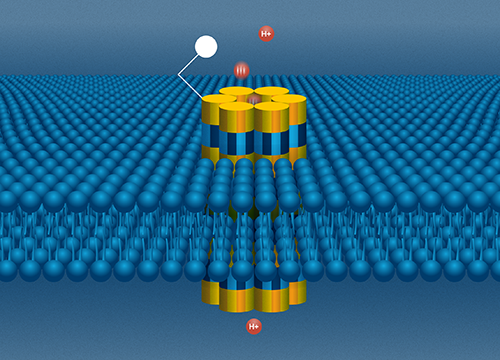In living organisms, cells have a very high capacity to process and communicate information by moving molecules or ions through tiny channels that span the cell membrane. UC Santa Cruz Professor of Electrical and Computer Engineering Marco Rolandi’s lab and collaborators at MIT have created a device that mimics this biological concept in order to detect disease.
 The bioprotonic system. A DNA nanopore sits in a lipid bilayer as an electrode sends a stream of protons through the channel. Image Credit: Molly Fine
The bioprotonic system. A DNA nanopore sits in a lipid bilayer as an electrode sends a stream of protons through the channel. Image Credit: Molly Fine
Using their bioprotonic system, a device that integrates electronic components with biological components and uses electrical currents of protons, the researchers can detect biomolecules that indicate the presence of human disease, among other applications. Details on this device were newly published in the journal Nature Communications.
“Cells tend to be interconnected — they talk to each other, or they talk to the external environment, using these intermembrane channels,” Rolandi said. “What we set out to do with our collaborators at MIT was create an artificial ion channel in a way that we could tune the properties of the ion channel and its functionality as we desire.”
Using a technique called DNA origami, the researchers at MIT can bioengineer a strand of DNA, which naturally forms the shape of a double helix, into any shape that they want. For this project, they created a tiny tunnel specially programmed for a stream of protons (H-plus) to optimally travel through. This tiny channel is known as a nanopore, a concept which was originally pioneered at UCSC.
The DNA nanopore sits within Rolandi’s bioprotonic system, which is designed to mimic the watery, ion-conducting world of the cellular environment. A double layer of lipids similar to a cell membrane separates water representing the environment outside of a cell from an electrode representing the inside of a cell, and the embedded nanopore acts as a channel between the two sides.
The electrode sends a stream of protons through the nanopore channel to the other side of the nanopore, where there is a molecule binding site that can be customized so specific biomolecules of interest attach to it. If one of those molecules is present in the water, it will attach to one end of the nanopore and block the stream of protons through the channel.
The device translates the proton signal into an electronic signal that the researchers can read. When the device does not detect protons flowing through the channel, the researchers know that a biomolecule is present.
The device also includes two handles made of cholesterol which position themselves across the lipid bilayer and improve the conductivity of protons through the nanopore channel.
“The uniqueness of the approach is the combination of these proton-conducting devices with supportive lipid bilayers, and I believe we are the only groups that are working on those, with this dock design for the DNA nanopores,” Rolandi said. “The novelty is both the integration of the device and the ability to sense using these DNA nanopores.”
In the paper, the researchers show that they are able to use the bioprotonic system for the detection of the biomolecule B-type natriuretic peptide, an indicator of cardiac disease. This shows the potential of the device to be used for biomolecule detection in an in-vitro or clinical setting.
In the future, the researchers envision the device could contain multiple nanopores, each programmed to detect a different type of biomolecule.
“It’s definitely part of the attractiveness of the system — in the near future we could multiplex, so we could have a full suite of biosensors,” Rolandi said.
UCSC researchers Le (Dante) Luo, Yunjeong Park, and Jesse Sanchez contributed to this paper. Researchers from the University of Washington and the TOBB University of Economics and Technology in Ankara, Turkey also participated in this project. The research was supported by the National Science Foundation.